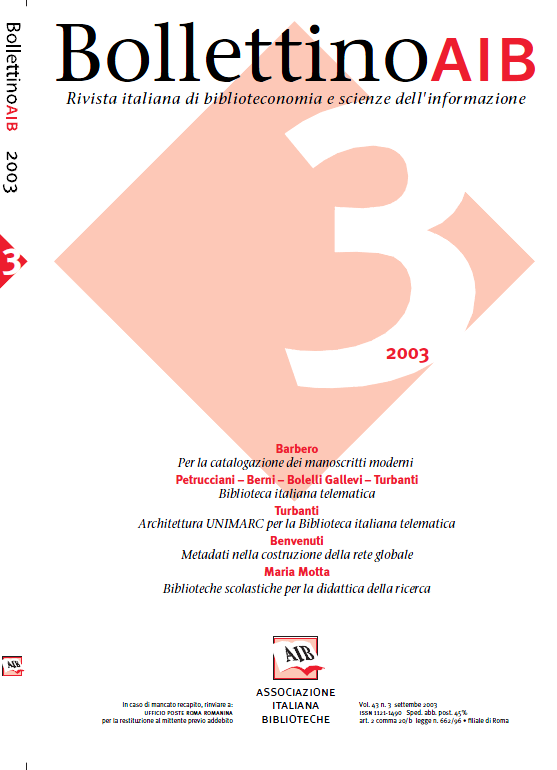Per la catalogazione dei manoscritti moderni
Contenuto principale dell'articolo
Abstract
There are numerous ways for describing and cataloguing modern and contemporary manuscripts. These ways are connected to different subjects and environments. The article examines some of these experiences, while attempting to define and identify the aims and methods applied by each one of them.
Within the field of modern philology in Italy, very accurate descriptions have been produced, usually in paper form. These have served to introduce the study and editing of texts. Book historians have dealt with defining some of the main types of manuscripts produced in the age of printing, emphasizing their functions and formal characteristics. Lastly, those who deal with cataloguing have sought suitable solutions for adapting the description of non-book manuscripts to that of the medieval codes or of archival material. Following a genetic criticism, in France studies have been carried out that are very attentive to the physical aspects of author's papers(**), while library cataloguers in the United States have been guided by their anxiety to reconcile the catalogue of printed matter and that of manuscripts through a single standard, while still maintaining the practise of producing brief summaries of their origins. Added to this are the numerous in-depth theoretical reflections on the archival nature of modern manuscripts, which however do not seem to solve the practical problem of the cataloguing of this material, which is often found scattered within institutions of various kinds (libraries, research centres, archives).
While underlining the importance of identifying between contents of the descriptions, cataloguing rules and electronic standards, the last part of the article offers some observations on the descriptive elements to be used in the file-card of a modern manuscript: origin, groups of manuscripts, marking, container, material composition, matter, paper and texture, arrangement of the text, writing, hands, inks and writers' instruments, ornamentation, binding, editions and printing and philological information.
Within the field of modern philology in Italy, very accurate descriptions have been produced, usually in paper form. These have served to introduce the study and editing of texts. Book historians have dealt with defining some of the main types of manuscripts produced in the age of printing, emphasizing their functions and formal characteristics. Lastly, those who deal with cataloguing have sought suitable solutions for adapting the description of non-book manuscripts to that of the medieval codes or of archival material. Following a genetic criticism, in France studies have been carried out that are very attentive to the physical aspects of author's papers(**), while library cataloguers in the United States have been guided by their anxiety to reconcile the catalogue of printed matter and that of manuscripts through a single standard, while still maintaining the practise of producing brief summaries of their origins. Added to this are the numerous in-depth theoretical reflections on the archival nature of modern manuscripts, which however do not seem to solve the practical problem of the cataloguing of this material, which is often found scattered within institutions of various kinds (libraries, research centres, archives).
While underlining the importance of identifying between contents of the descriptions, cataloguing rules and electronic standards, the last part of the article offers some observations on the descriptive elements to be used in the file-card of a modern manuscript: origin, groups of manuscripts, marking, container, material composition, matter, paper and texture, arrangement of the text, writing, hands, inks and writers' instruments, ornamentation, binding, editions and printing and philological information.
Dettagli dell'articolo
Fascicolo
Sezione
Articoli

Questo lavoro è fornito con la licenza Creative Commons Attribuzione - Condividi allo stesso modo 4.0.
